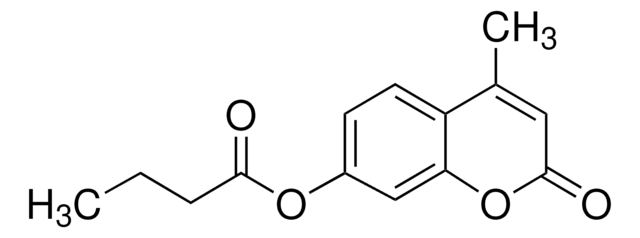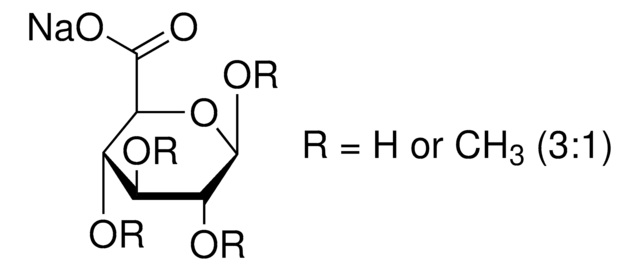69602
4-Methylumbelliferyl-β-D-glucuronide hydrate
β-glucuronidase substrate, fluorogenic, ≥99.0% (HPLC), powder or crystals, suitable for fluorescence
Synonym(s):
4-Methylumbelliferyl-β-D-glucopyranosiduronic acid, MUG
About This Item
Recommended Products
Product Name
4-Methylumbelliferyl-β-D-glucuronide hydrate, suitable for fluorescence, ≥99.0% (HPLC)
Assay
≥99.0% (HPLC)
form
powder or crystals
impurities
≤0.1% free 4-Methylumbelliferone
≤15% water
solubility
DMSO: 50 mg/mL, clear, colorless to very faintly yellow
fluorescence
λex 365 nm; λem 445 nm in 0.1 M phosphate pH 6.5
suitability
suitable for fluorescence
storage temp.
−20°C
SMILES string
O.CC1=CC(=O)Oc2cc(O[C@@H]3O[C@@H]([C@@H](O)[C@H](O)[C@H]3O)C(O)=O)ccc12
InChI
1S/C16H16O9.H2O/c1-6-4-10(17)24-9-5-7(2-3-8(6)9)23-16-13(20)11(18)12(19)14(25-16)15(21)22;/h2-5,11-14,16,18-20H,1H3,(H,21,22);1H2/t11-,12-,13+,14-,16+;/m0./s1
InChI key
URVSQZMOFUEQAW-YYHOVTOASA-N
Looking for similar products? Visit Product Comparison Guide
General description
Application
- as a β-glucuronidase (GUS) substrate for fluorimetric analysis of reporter gene expression in Arabidopsis thaliana
- for the fluorimetric assay for GUS activity
- to measure liposome lysis by n-octylglucoside
Storage Class Code
11 - Combustible Solids
WGK
WGK 3
Flash Point(F)
Not applicable
Flash Point(C)
Not applicable
Personal Protective Equipment
Choose from one of the most recent versions:
Already Own This Product?
Find documentation for the products that you have recently purchased in the Document Library.
Customers Also Viewed
Our team of scientists has experience in all areas of research including Life Science, Material Science, Chemical Synthesis, Chromatography, Analytical and many others.
Contact Technical Service











